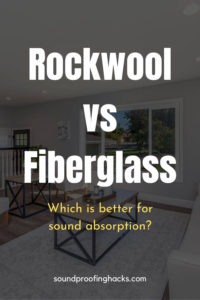Rockwool vs Fiberglass for Sound Absorption: Comparison
The main difference between rockwool and fiberglass for sound absorption is down to the frequency of noise they absorb. Rockwool is made of mineral wool and is better at absorbing low frequency sound ranges while fiberglass contains small particles of glass and suited for most soundproofing jobs.
I have been dabbling with lots of different soundproofing materials, ranging from household items to premium tools such as soundproofing mats to regular items such as door drafts and soundproof curtains.

What has come up regularly over the years is Rockwool and fiberglass, both of which I have used for various soundproofing projects.
I usually use then for larger scale projects, and had used them interchangeably, till I decided to investigate deeper and find make a Rockwool vs fiberglass comparison to see which is better for sound absorption.
Personally, I prefer this technique as the overall acoustics in a room is better, compared to simply using materials that block or reflect sounds.
So, what;’s the difference? Stay tuned for the conclusion.
I am an Affiliate for Amazon and others, which means I may make a commission if you purchase something through the links here. There is NO extra cost to you at all, and THANK YOU so much for the support. Learn more here.
Contents: Skip to section
What is rockwool/stone wool/mineral wool?
Essentially, all 3 of them represents the same thing, with Rockwool being the main manufacturer of the products.
As the name suggests, Rockwool is made up from real rocks. Natural rocks are heated at extreme temperatures till they melt and take up a molten form. This liquid is then spun rapidly in chambers to make fibres out of it. Think of candy floss, it’s a quite similar way in which they are produced.
After attaining the fibrous structure, they are morphed into a wool-like form. The final product is just a mass of fibres intertwined with each other with the help of starch.
Commercially, it available in the form of batts, rolls and sometimes loose-fill form.
An interesting fact about Rolux (as the brand was called a few years ago) is that if you test it in form of individual fibres, it conducts heat very efficiently. But, as soon as it gets condensed in the form of sheets or rolls, it acquires the ability to trap air. And, this is the reason why it is an excellent heat and sound insulator.
For the same reason, it is able to provide airtightness to the room it is installed in. But still, it is very breathable. You just have to insert it where the requirement is and it will fit in there perfectly. No need for extra staples.
If you install Rolux insulation in your home, you will notice that it significantly reduces the energy consumption (given it’s thermoinsulating feature). And that’s how it compensates for its high price.
Also, there isn’t going to be any risk of growth of mould or bacterial colonies. This is because it allows air moisture to escape freely.
Now, let’s have a look at a few technical values:
- STC rating (the ability of a material to reduce sound transmission) – 40 to 60
- NRC rating (sound absorption capacity of a material) – 0.70 to 0.90
- R value (measurement of how well a material can resist the flow of heat) – 3.1 to 4.0
Above all, Rockwool insulation is environment friendly. As it is made up of natural materials only, it doesn’t degrade over time. It can last as long as your house can (again, compensating for it’s high price).
What is Fiberglass?
Fibreglass is composed of randomly arranged glass fibres held together with the help of a binding substance. Basically, you can call it a reinforced plastic material (which is why it is also called Glass Reinforced Plastic).
The procedure of its production is not much different than that of Rockwool. Sand is heated at high temperatures to form glass. The glass is then spun swiftly to obtain fibres.
Acoustic fibreglass consists of relatively smaller particles of compressed glass.
It is light weight but is a very strong material. It’s amazing to know that its specific resistance is even higher than that of steel.
Just like Rockwool, you can find it in forms of rolls, batts, loose-fill form and also rigid boards and insulation. It is corrosion proof, weather resistant and also blocks out UV rays. Low thermal conductivity and electrical insulation are some of its other features.
But, what about sound? This is what I like the most about it. Unlike majority of other sound dampening options, it doesn’t block or reflect sound. Instead, it absorbs. If sound is just being reflected, it causes echo and echo can sometimes be a bigger problem than usual sound, especially if in a studio/music room environment.
You can estimate its efficiency by the fact that it can reduce the noise levels by around 3-5 decibels. Even though it may not seem to be very much effective, it is sufficient for household needs.
Now, the data part :
- STC rating – 30 to 35
- NRC rating – 0.90 to 0.95
- R value – 2.7 to 4.3
Fibreglass can be of blown-in type or batts/rolls type. Both have different purposes and different insulation values. The stats here are an average of both.
Pros and Cons of using Rockwool
Pros of Rockwool
- It is hydrophobic, meaning that even if it gets wet, there’s no problem. It will retain all its properties as they were after drying up.
- Rockwool batts doesn’t end up getting damaged while installing while fiberglass ones can. These are the easiest to install and fits perfectly without staples.
- It doesn’t let termites own a territory on its surface. You can find termites on almost every kind of foam insulation but not this.
- It possess relatively lesser health risks as compared to fibreglass.
- The level of fire resistance provided by stone wool is impressive, perfect for constructing drywalls or insulating plywood walls.
Cons of Fiberglass
- It costs higher to install this insulation.
There are not as many size options available as in fibreglass.
High density makes it tricky to handle sometimes.
Pros and Cons of using Fiberglass
Pros of Fiberglass
- Its material is very strong and resistant to corrosion.
- Fibreglass insulation isn’t only functional but also visually appealing.
- It absorbs sound instead of bouncing it off.
- Lower density makes it easy to handle.
- A wide range of size options are available.
Cons of Fiberglass
- You have to take care that it doesn’t come in contact with moisture.
- It’s not as much effective against sound due to less thickness and low density.
- Thermal insulation is not up to mark.
Applications of Rockwool
- Because of it’s exceptional ability to resist heat, it is often used in buildings as a fire prevention measure. It won’t completely eliminate the danger but will slow down the further spread of fire for sure.
- Having water retaining property, it is widely used by gardeners as a hydroponic growth medium for plants.
- Thermal insulation is also one of its use.
- Some industries, buildings and even homeowners use it for soundproofing purpose, for example creating your own DIY soundproof panels, soundproofing your basement apartment, or even in your bathroom!
- It can also be used in manufacture of acoustical ceiling tiles.
- Since it is made up of compression resistant material, it can be used as roofing boards or bonded panels.
Applications of Fiberglass
Due to its versatility, fibreglass is used in a great variety of places. Some common ones are:
- Construction
- Vehicles
- Marine services
- Electronics
- Housing
- Swimming pools, hot tubs and bath tubs
- Protective gears in sports
- Storage tanks
- Piping
- 10.Drum sets
- 11.Handles of equipment
- 12.Aviation
Recommended products
Rockwool Acoustic Mineral Wool Insulation
Fiberglass Acoustic Sound Absorbing Panel Tiles
Frequently Asked Questions
Is fiberglass good for soundproofing?
Yes, fibreglass is definitely a good choice to soundproof your home. Though, it can’t do much about the noise coming from outside, it’s still effective for inside noises. This is because it absorbs sound rather than reflecting.
Is Rockwool better than fiberglass?
Yes, Rockwool has higher sound insulating value than fibreglass. Plus, it:
- involves fewer health risks
- is easier to install
- proves to be cheaper in the long term
Is mineral wool safe to use?
Like any other fibre or woollen material, mineral wool can also cause temporary irritation on skin or eyes. It’s always better to take precaution and wear gloves, mask and goggles.
Do I need a vapor barrier when using Rockwool?
No. Rockwool is itself water resistant due to it’s high density. There’s no need of an additional vapor barrier to protect it (as we need in fibreglass).
Does Rockwool have formaldehyde?
Yes, phenol formaldehyde binder is used in its production. But during the process, the heat is so high that most of it degrades. Only trace amounts are left in the end product.
Does Rockwool cause itch like fiberglass?
Yes, it can. But it’s true for most of the other fibres as well. It depends on person to person if you’ll experience it or not. And, it’s never a bad idea to take precautions by wearing gloves when handling either of these materials.
Rockwool vs Fiberglass conclusion
As you can see, there are many pros and cos for using either one of these soundproofing materials.
Both of them can do the job well, so when it comes down to choosing which to use, it will highly depend on your objective, size of project, as well as the budget involved.
Overall, I would say that Rockwool is better at sound absorption, but if it is a home environment and you do not have a large budget, fiberglass comes in as a competent substitute.
I hope this helps you in making your choice between Rockwool and fiberglass for sound absorption projects from here on.
Other interesting reads:



